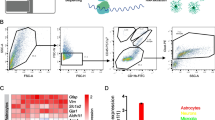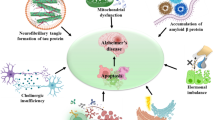Abstract
Epilepsy (SE) is a common and serious neurological disease. NOD-like receptor family pyrin domain-containing 3 (NLRP3) inflammasome participates in the pathogenesis of SE, while its underlying mechanism is still unclear. Here, we attempted to explore the mechanism of action of NLRP3 inflammasome in SE. SE mouse model was constructed by administration of kainic acid (KA). Astrocytes were treated with KA to mimic SE cell model. MCC950 (NLRP3 inhibitor) and Z-YVAD-FMK (Caspase-1 inhibitor) were used to treat astrocytes to inhibit the activity of NLRP3 and Caspase-1. Nissl staining was performed to examine the morphology of neuron. Western blot, enzyme-linked immunosorbent assay and immunofluorescence staining were performed to assess protein expression. SE mouse model exhibited an increase of neuronal loss, and an up-regulation of Cleaved-Caspase-1, IL-1β and IL-18 in hippocampus. The levels of GFAP+ADK+ cells were significantly increased in SE mice. MCC950 or Z-YVAD-FMK abolished these impacts conferred by KA in SE mice. Moreover, KA treatment enhanced the expression of NLRP3, Cleaved-Caspase-1, IL-1β and IL-18 in astrocytes, which was rescued by knockdown of NLRP3 or Caspase-1. Additionally, CREB, p-CREB, REST were up-regulated, and SP1 was down-regulated in the KA-treated SE mice and KA-treated astrocytes. Inhibition of NLRP3 or Caspase-1 rescued these proteins expression in KA-treated astrocytes. CREB or REST silencing reduced adenosine kinase (ADK) expression, while SP1 knockdown enhanced ADK expression in KA-treated astrocytes. In conclusion, NLRP3 inflammasome activation enhances ADK expression to accelerate SE in mice through regulating CREB/REST/SP1 signaling pathway. Thus, inhibition of NLRP3 inflammasome may be a treatment for SE.




Similar content being viewed by others
Data Availability
The datasets used and/or analysed during the current study are available from the corresponding author on reasonable request.
References
Sadeghi S, Fayed N, Ronen G (2014) Patient-reported outcome measures in pediatric epilepsy: a content analysis using World Health Organization definitions. Epilepsia 55:1431–1437
Manford M (2017) Recent advances in epilepsy. J Neurol 264:1811–1824
Weltha L, Reemmer J, Boison D (2019) The role of adenosine in epilepsy. Brain Res Bull 151:46–54
Boison D, Steinhäuser C (2018) Epilepsy and astrocyte energy metabolism. Glia 66:1235–1243
Gebril H, Wahba A, Zhou X, Lai T, Alharfoush E, DiCicco-Bloom E, Boison D (2021) Developmental role of adenosine kinase in the cerebellum. eNeuro. https://doi.org/10.1523/ENEURO.0011-21.2021
Aronica E, Sandau U, Iyer A, Boison D (2013) Glial adenosine kinase—a neuropathological marker of the epileptic brain. Neurochem Int 63:688–695
Sandau U, Yahya M, Bigej R, Friedman J, Saleumvong B, Boison D (2019) Transient use of a systemic adenosine kinase inhibitor attenuates epilepsy development in mice. Epilepsia 60:615–625
Kelley N, Jeltema D, Duan Y, He Y (2019) The NLRP3 inflammasome: an overview of mechanisms of activation and regulation. Int J Mol Sci 20:3328
Van Opdenbosch N, Lamkanfi M (2019) Caspases in cell death, inflammation, and disease. Immunity 50:1352–1364
Haneklaus M, O’Neill L, Coll R (2013) Modulatory mechanisms controlling the NLRP3 inflammasome in inflammation: recent developments. Curr Opin Immunol 25:40–45
Yue J, Wei Y, Yang X, Liu S, Yang H, Zhang C (2020) NLRP3 inflammasome and endoplasmic reticulum stress in the epileptogenic zone in temporal lobe epilepsy: molecular insights into their interdependence. Neuropathol Appl Neurobiol 46:770–785
Rong S, Wan D, Fan Y, Liu S, Sun K, Huo J, Zhang P, Li X, Xie X, Wang F, Sun T (2019) Amentoflavone affects epileptogenesis and exerts neuroprotective effects by inhibiting NLRP3 inflammasome. Front Pharmacol 10:856
de Brito Toscano CE, Leandro Marciano Vieira É, Boni Rocha Dias B, Vidigal Caliari M, Paula Gonçalves A, Varela Giannetti A, Maurício Siqueira J, Kimie Suemoto C, Elaine Paraizo Leite R, Nitrini R, Alvarenga Rachid M, Lúcio Teixeira A (2021) NLRP3 and NLRP1 inflammasomes are up-regulated in patients with mesial temporal lobe epilepsy and may contribute to overexpression of caspase-1 and IL-β in sclerotic hippocampi. Brain Res 1752:147230
Shen K, Mao Q, Yin X, Zhang C, Jin Y, Deng A, Gu Z, Chen B (2018) NLRP3 inflammasome activation leads to epileptic neuronal apoptosis. Curr Neurovasc Res 15:276–281
Kiese K, Jablonski J, Boison D, Kobow K (2016) Dynamic regulation of the adenosine kinase gene during early postnatal brain development and maturation. Front Mol Neurosci 9:99
Zhao Y, Zhu M, Yu Y, Qiu L, Zhang Y, He L, Zhang J (2017) Brain REST/NRSF is not only a silent repressor but also an active protector. Mol Neurobiol 54:541–550
Wang Y, Kong H, Zeng X, Liu W, Wang Z, Yan X, Wang H, Xie W (2016) Activation of NLRP3 inflammasome enhances the proliferation and migration of A549 lung cancer cells. Oncol Rep 35:2053–2064
Wang J, Huang J, Li YQ, Yao S, Wu CH, Wang Y, Gao F, Xu MD, Huang GB, Zhao CQ, Wu JH, Zhang YL, Jiao R, Deng ZH, Jie W, Li HB, Xuan A, XD S, (2021) Neuregulin 1/ErbB4 signaling contributes to the anti-epileptic effects of the ketogenic diet. Cell Biosci 11:29
Racine RJ (1972) Modification of seizure activity by electrical stimulation. I. After-discharge threshold. Electroencephalogr Clin Neurophysiol 32:269–279
He Q, Jiang L, Man S, Wu L, Hu Y, Chen W (2018) Curcumin reduces neuronal loss and inhibits the NLRP3 inflammasome activation in an epileptic rat model. Curr Neurovasc Res 15:186–192
Henshall D, Simon R (2005) Epilepsy and apoptosis pathways. J Cereb Blood Flow Metab Off J Int Soc Cereb Blood Flow Metab 25:1557–1572
Chen D, Wang W, Chen Y, Yang X, Zhao M, Yang Y (2019) miR-128 is upregulated in epilepsy and promotes apoptosis through the SIRT1 cascade. Int J Mol Med 44:694–704
Fan Y, Wang W, Li W, Li X (2020) miR-15a inhibits cell apoptosis and inflammation in a temporal lobe epilepsy model by downregulating GFAP. Mol Med Rep 22:3504–3512
Kimura H, Kushima I, Yohimi A, Aleksic B, Ozaki N (2018) Copy number variant in the region of adenosine kinase (ADK) and its possible contribution to schizophrenia susceptibility. Int J Neuropsychopharmacol 21:405–409
Theofilas P, Brar S, Stewart K, Shen H, Sandau U, Poulsen D, Boison D (2011) Adenosine kinase as a target for therapeutic antisense strategies in epilepsy. Epilepsia 52:589–601
de Groot M, Iyer A, Zurolo E, Anink J, Heimans J, Boison D, Reijneveld J, Aronica E (2012) Overexpression of ADK in human astrocytic tumors and peritumoral tissue is related to tumor-associated epilepsy. Epilepsia 53:58–66
Wang G, Zhu Z, Xu D, Sun L (2020) Advances in understanding CREB signaling-mediated regulation of the pathogenesis and progression of epilepsy. Clin Neurol Neurosurg 196:106018
Lopez de Armentia M, Jancic D, Olivares R, Alarcon J, Kandel E, Barco A (2007) cAMP response element-binding protein-mediated gene expression increases the intrinsic excitability of CA1 pyramidal neurons. J Neurosci Off J Soc Neurosci 27:13909–13918
Navarrete-Modesto V, Orozco-Suárez S, Alonso-Vanegas M, Feria-Romero I, Rocha L (2019) REST/NRSF transcription factor is overexpressed in hippocampus of patients with drug-resistant mesial temporal lobe epilepsy. Epilepsy Behav 94:118–123
Lee M, Park J, Gi S, Hwang Y (2018) IL-1β induces fascin expression and increases cancer invasion. Anticancer Res 38:6127–6132
Buffolo F, Petrosino V, Albini M, Moschetta M, Carlini F, Floss T, de Rosbo KN, Cesca F, Rocchi A, Uccelli A, Benfenati F (2021) Neuroinflammation induces synaptic scaling through IL-1β-mediated activation of the transcriptional repressor REST/NRSF. Cell Death Dis 12:180
Meng X, Tan L, Tan M, Jiang T, Tan C, Li M, Wang H, Yu J (2014) Inhibition of the NLRP3 inflammasome provides neuroprotection in rats following amygdala kindling-induced status epilepticus. J Neuroinflamm 11:212
Ye Q, Zeng C, Dong L, Wu Y, Huang Q, Wu Y (2019) Inhibition of ferroptosis processes ameliorates cognitive impairment in kainic acid-induced temporal lobe epilepsy in rats. Am J Transl Res 11:875–884
Henshall D, Murphy B (2008) Modulators of neuronal cell death in epilepsy. Curr Opin Pharmacol 8:75–81
Acknowledgements
Not applicable.
Funding
This work was supported by the National Nature Science Foundation of China [Grant NSFC 81901318 (to Dr. Haiju Zhang)].
Author information
Authors and Affiliations
Contributions
HZ designed the study and wrote the paper; HZ, SY, LX, XP, SW, BY contributed to the experiments and the data analysis. All authors read and approved the paper.
Corresponding author
Ethics declarations
Conflict of interest
The authors have no relevant financial or non-financial interests to disclose.
Ethical Approval
This study was approved by the Ethics Committee of Renmin Hospital of Wuhan University.
Consent for Publication
Not applicable.
Additional information
Publisher's Note
Springer Nature remains neutral with regard to jurisdictional claims in published maps and institutional affiliations.
Supplementary Information
Below is the link to the electronic supplementary material.
11064_2021_3479_MOESM1_ESM.tif
Supplementary file1 (TIF 220 kb) Supplementary Fig. 1 The expression of NLRP3, REST, Caspase-1, SP1 and CREB in astrocytes. The qRT-PCR was performed to assess the expression of NLRP3, REST, Caspase-1, SP1 and CREB in astrocytes following transfection of NLRP3 siRNA, REST siRNA, Caspase-1 siRNA, SP1 siRNA, CREB siRNA or Scramble siRNA. ***P < 0.001 vs. Scramble siRNA
Rights and permissions
About this article
Cite this article
Zhang, H., Yu, S., Xia, L. et al. NLRP3 Inflammasome Activation Enhances ADK Expression to Accelerate Epilepsy in Mice. Neurochem Res 47, 713–722 (2022). https://doi.org/10.1007/s11064-021-03479-8
Received:
Revised:
Accepted:
Published:
Issue Date:
DOI: https://doi.org/10.1007/s11064-021-03479-8




